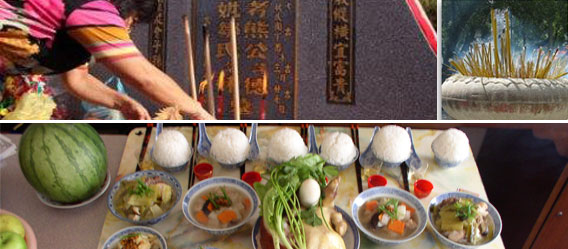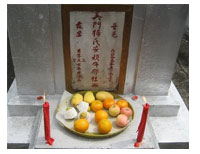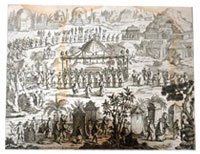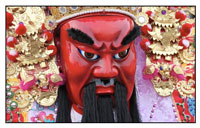
On April 4th, the Chinese celebrates the Qing Ming festival. During this festival, the ancestors and deceased are commemorated. Family members visit the graves of their ancestors and sweep the grave, bring offerings of fruits, food, tea, wine and joss sticks, as well as paper money to be burnt as gift offerings for the dead.
In recognition of the Qing Ming festival, and because several of our valued customers have made this newsletter topic suggestion, this month’s newsletter will take a look at Chinese funeral rites as well as the Chinese concept of death and rebirth.
Chinese Funerals Today
 Today, Chinese funerals are often widely varied. Dependent on the religious belief of a person and his or her family, Chinese funerals can be very different, and there is no one single determined way of conducting the final rites of the deceased.
Today, Chinese funerals are often widely varied. Dependent on the religious belief of a person and his or her family, Chinese funerals can be very different, and there is no one single determined way of conducting the final rites of the deceased.
Traditionally, Chinese funerals often employed Buddhist or Taoist funerary rites, but today, with a wide Christian and Catholic population, many Chinese funerals also follow Christian or Catholic funerary rites.
The Traditional Chinese View on Death and Rebirth
 The traditional Chinese view of death is a mixture of Buddhist and Taoist beliefs and folk legends. The practice of ancestor worship or paying respect to deceased ancestors stems from a belief that the spirits of ancestors continue to reside in the afterlife and can bring blessings and aid to their descendants. Although many Chinese today, no longer believe in this view, the practice of grave sweeping and paying respect to the deceased is continued as a cultural practice and a form of filial piety. The traditional Chinese view of death is a mixture of Buddhist and Taoist beliefs and folk legends. The practice of ancestor worship or paying respect to deceased ancestors stems from a belief that the spirits of ancestors continue to reside in the afterlife and can bring blessings and aid to their descendants. Although many Chinese today, no longer believe in this view, the practice of grave sweeping and paying respect to the deceased is continued as a cultural practice and a form of filial piety.
Traditionally, the Chinese believed that in death, the souls of the dead are first brought through the ten courts of hell. This belief was influenced by the Buddhist concept of Naraka—a Buddhist concept of purgatory. The Chinese concept of hell was later expanded on by other Chinese folk beliefs.
 According to traditional Chinese beliefs, all souls upon death are first brought to the ten courts of Hell where they will be judged by the Yama Kings of each of the ten court, who will look at the lives of the deceased and determine if he/she has committed any of the crimes of his court. Each court of hell punishes souls for specific crimes through various ways of torture in punishment. According to traditional Chinese beliefs, all souls upon death are first brought to the ten courts of Hell where they will be judged by the Yama Kings of each of the ten court, who will look at the lives of the deceased and determine if he/she has committed any of the crimes of his court. Each court of hell punishes souls for specific crimes through various ways of torture in punishment.
In Chinese belief system, everyone who has died first goes through the courts of hell and depending on their numbers of sins and the severity of their sins spend different duration in hell, after which they will be reborn.
This belief is populated by various mythical characters. It was said that the King Yama, the overseer of hell, was appointed by the Jade Emperor, the deity in the heavenly court who oversees all the other deities. Under the supervision of King Yama are two guards of hell: Ox head and Horse face. As their names describe, one of the guards has the head of an ox and the other has the face of a horse. They are the first beings, souls would see when entering hell. They guard the gate of hell and are often dispatched by King Yama to capture wandering spirits who escape from their capture.
After going through all ten courts of hell, the souls will then encounter Meng Po, an old lady who makes a special bland of drink for all the souls who have passed through hell. The drink will make them forget their previous lives before they are sent to be reincarnated. Depending on the lives led by the souls, they could be reincarnated as human or a lower life form. Their previous lives will also determine if they will be born to a good family or a poor one.
Occasionally, rare souls who have led exemplary lives would not have to go through the ten courts of hell. They will be led to the golden or silver bridge where they could make a choice between the two.
The Golden bridge leads to the “Pure Land of the West”, which is the domain of the Buddha Amitabha and which is not a part of the cosmos. After the soul’s encounter with the Buddha Amitabha, the soul would be released from the cycle of birth and rebirth, and would achieve what institutional Buddhism calls “nirvana”.
The Silver bridge leads to “Heaven” which is a part of the cosmos, and which is ruled over by the Jade Emperor and is resided by gods and heavenly officials. The souls entering through the silver bridge would be reborn as a god and would become an important figure in the cosmos.
Traditional Chinese Funerary Rites
 In accordance with the traditional Chinese beliefs of death, rebirth and hell, traditional Chinese funerary rites are heavily influenced by these beliefs. During Chinese funerals, the family members of the deceased usually wear white. The jute fabric (sack cloth) is especially closely related to death in the family and mourning. Relatives of the deceased usually wear white and the immediate family of the deceased (the children and daughter-in-laws) often wear jute head dress or vests as signs of mourning.
In accordance with the traditional Chinese beliefs of death, rebirth and hell, traditional Chinese funerary rites are heavily influenced by these beliefs. During Chinese funerals, the family members of the deceased usually wear white. The jute fabric (sack cloth) is especially closely related to death in the family and mourning. Relatives of the deceased usually wear white and the immediate family of the deceased (the children and daughter-in-laws) often wear jute head dress or vests as signs of mourning.
Typically, color ribbons worn by family members tell guests the relation of family members to the deceased. Usually, only the immediate family members of the deceased wear black, or a black ribbon.
Grandchildren of the deceased wear the color blue in their hair or on their mourning clothes. More distant relatives wear a variety of other colors.
Before the funeral, the Chinese usually hold a wake for deceased where photos of the deceased will be placed, as well as flowers and candles by the body of the deceased as family members keep vigil over the body for at least a night, sometimes, the wake can be several days long.
It is during the wake, that family and friends bring wreaths of flowers with banners of name of the givers, as well as messages for the deceased or family members as condolences. A white envelope, similar in concept to the red packet that is reserved only for auspicious occasions, is given to family members of the deceased. According to tradition, the amount in the white envelope must be odd. The belief is that for auspicious occasions, the wish is for double happiness, hence the even number in red packets, but at funerals, the amount given to family must be odd.
 At the funeral, Taoist or Buddhist chants are recited by Taoist priests or Buddhist monks, to guide the spirits of the deceased safely to the netherworld. Joss papers are also burnt, and incense offerings are made as well. Often, miniature cars, houses, even servants made from paper are burnt during the funeral as gifts to the departed It is believed that burning the offers would deliver them to the nether world for the deceased to use.
At the funeral, Taoist or Buddhist chants are recited by Taoist priests or Buddhist monks, to guide the spirits of the deceased safely to the netherworld. Joss papers are also burnt, and incense offerings are made as well. Often, miniature cars, houses, even servants made from paper are burnt during the funeral as gifts to the departed It is believed that burning the offers would deliver them to the nether world for the deceased to use.
At the end of the funeral, the family of the deceased will give out red envelopes to the guests, usually containing a coin, as a wish that guests would return home safely. A candy will also be distributed to guests that must be consumed on the day before returning home.
After the funeral, a funeral procession made up of a hired band and a vehicle containing the casket makes it way to the cemetery or crematorium. Family members and friends will walk behind the band way and the hearse containing the casket and a large photo of the deceased placed in the front. The band plays music to frighten away ghost and spirits.
Depending on the preference of the deceased and his/her family members, a burial or a cremation follows.
In memory of the deceased, family members will visit the grave, bringing flowers, and offerings of food and wine to pay respect to the dead. Annually, the Qing Ming festival in April is a time when families gather to pay respect to the deceased.
|


 Today, Chinese funerals are often widely varied. Dependent on the religious belief of a person and his or her family, Chinese funerals can be very different, and there is no one single determined way of conducting the final rites of the deceased.
Today, Chinese funerals are often widely varied. Dependent on the religious belief of a person and his or her family, Chinese funerals can be very different, and there is no one single determined way of conducting the final rites of the deceased.  The traditional Chinese view of death is a mixture of Buddhist and Taoist beliefs and folk legends. The practice of ancestor worship or paying respect to deceased ancestors stems from a belief that the spirits of ancestors continue to reside in the afterlife and can bring blessings and aid to their descendants. Although many Chinese today, no longer believe in this view, the practice of grave sweeping and paying respect to the deceased is continued as a cultural practice and a form of filial piety.
The traditional Chinese view of death is a mixture of Buddhist and Taoist beliefs and folk legends. The practice of ancestor worship or paying respect to deceased ancestors stems from a belief that the spirits of ancestors continue to reside in the afterlife and can bring blessings and aid to their descendants. Although many Chinese today, no longer believe in this view, the practice of grave sweeping and paying respect to the deceased is continued as a cultural practice and a form of filial piety.
 According to traditional Chinese beliefs, all souls upon death are first brought to the ten courts of Hell where they will be judged by the Yama Kings of each of the ten court, who will look at the lives of the deceased and determine if he/she has committed any of the crimes of his court. Each court of hell punishes souls for specific crimes through various ways of torture in punishment.
According to traditional Chinese beliefs, all souls upon death are first brought to the ten courts of Hell where they will be judged by the Yama Kings of each of the ten court, who will look at the lives of the deceased and determine if he/she has committed any of the crimes of his court. Each court of hell punishes souls for specific crimes through various ways of torture in punishment.
 In accordance with the traditional Chinese beliefs of death, rebirth and hell, traditional Chinese funerary rites are heavily influenced by these beliefs. During Chinese funerals, the family members of the deceased usually wear white. The jute fabric (sack cloth) is especially closely related to death in the family and mourning. Relatives of the deceased usually wear white and the immediate family of the deceased (the children and daughter-in-laws) often wear jute head dress or vests as signs of mourning.
In accordance with the traditional Chinese beliefs of death, rebirth and hell, traditional Chinese funerary rites are heavily influenced by these beliefs. During Chinese funerals, the family members of the deceased usually wear white. The jute fabric (sack cloth) is especially closely related to death in the family and mourning. Relatives of the deceased usually wear white and the immediate family of the deceased (the children and daughter-in-laws) often wear jute head dress or vests as signs of mourning.
 At the funeral, Taoist or Buddhist chants are recited by Taoist priests or Buddhist monks, to guide the spirits of the deceased safely to the netherworld. Joss papers are also burnt, and
At the funeral, Taoist or Buddhist chants are recited by Taoist priests or Buddhist monks, to guide the spirits of the deceased safely to the netherworld. Joss papers are also burnt, and 